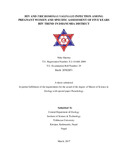Please use this identifier to cite or link to this item:
https://elibrary.tucl.edu.np/handle/123456789/1411| Title: | Hiv And Trichomonas Vaginalis Infection Among Pregnant Women and Specific Assessment of Five Years Hiv Trend In Dhanusha District |
| Authors: | Sharma, Neha |
| Keywords: | Disease;Weight Gain;Human Immune- Deficiency Virus |
| Issue Date: | Mar-2017 |
| Publisher: | Central Department of Zoology Institute of Science & Technology Tribhuvan University Kirtipur, Kathmandu, Nepal |
| Abstract: | HIV is a chronic debilitating disease which has engulfed a significant number of people. Globally, women share an indiscriminate burden of STIs and HIV and the associated socioeconomic consequences. There are increasing concerns related to prevalence of HIV infection among reproductive potential age groups, where HIV related risks and vulnerability are numerous among married individuals. The study was conducted in two parts: a) a prospective study in Aastha Hospital (private) and b) Risk assessment and HIV trend analysis of five years (2010/11-2014/15) records obtained from Antiretroviral Therapy Centre of Janakpur Zonal Hospital (government hospital). A prospective analytical study has been conducted among the pregnant women of Gynaecological and Obstetrics Department of Aastha Hospital, Janakpur, Nepal in order to determine the prevalence of HIV and Trichomonas vaginalis infection. A total of 120 pregnant women belonging to 20-46 years were included in the study. Blood samples were taken and tested for HIV using rapid diagnostic kits while samples for T. vaginalis infection were collected by taking vaginal swab with two cotton tipped sterile swab sticks and wet mount of the sample was prepared to be seen under a microscope. While none of them were found to be positive for trichomoniasis, HIV infection was found in 0.83% middle caste pregnant women. The second part of study included a total of 3770 individuals tested for HIV in ART centre of JZH accounting for 13.6% of positive prevalence. The complete five years data obtained from NCASC HIV positive case reporting forms were analysed statistically using SPSS (version 20). The key populations at risk were IDUs, sex workers, MSM, clients of sex workers, migrant workers, spouse of migrant workers, vertical transmission, housewives and others. The retrospective assessment of records showed high HIV prevalence (74.07%) among 25-49 years age group, males accounting for highest percentages (58.6%). Married individuals constituted 77.1% while 47.3% were middle caste. HIV infection was found to be highest in Dhanusha (40.7%) followed by Mahottari District (33.3%). Only 1.5% of women were in their current pregnancy status. HIV was found to be maximum among migrant workers (41%), followed by spouse of migrant workers (23%), Vertical transmission (16%), Housewives (5%), Others (12%), MSM (2%) and Client of sex workers (1%). Though HIV is prevalent in key risk groups, the situation of HIV in these five years is in steady phase |
| URI: | http://elibrary.tucl.edu.np/handle/123456789/1411 |
| Appears in Collections: | Zoology |
Items in DSpace are protected by copyright, with all rights reserved, unless otherwise indicated.

